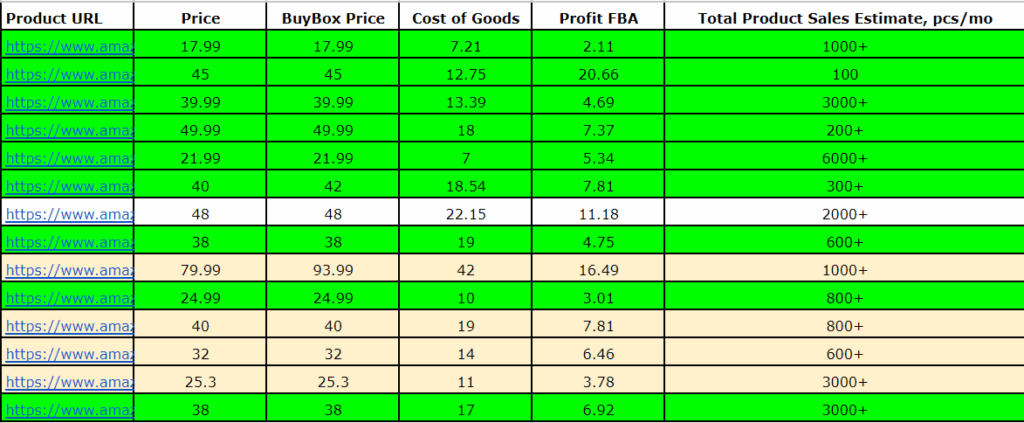Product research is one of the most crucial steps for anyone looking to sell successfully on Amazon. The right product can lead to significant profits, while the wrong product may result in poor sales and lost investments. Here are some proven best practices for effective product research to help you identify profitable opportunities and gain a competitive edge on Amazon.
1. Identify a Niche Market
Finding a niche can help reduce competition and allow you to target specific customer needs. Ideally, choose a niche that you’re passionate about or knowledgeable in, but it should also be broad enough to have a reasonable demand. Start by exploring categories on Amazon and analysing trends. Use keyword tools like Amazon’s Best Sellers Rank (BSR) and external tools like Jungle Scout or Helium 10 to identify high-demand categories with relatively low competition.
Tips:
- Look for products with a BSR between 1,000 and 10,000 in a specific category; this indicates healthy demand without intense competition.
- Avoid overly crowded markets with big-brand domination, as it can be difficult for new sellers to compete.

2. Evaluate Product Demand and Seasonality
Understanding demand is essential to ensure there’s a market for your product. However, it’s also important to account for seasonality; products like holiday decorations or winter sports gear may sell well during certain times but could be challenging in the off-season.
Use Google Trends to see if your product has a stable or growing demand over time. Tools like Jungle Scout’s Product Tracker can also give you daily sales estimates and historical data to understand sales patterns and seasonality for specific products.
Tips:
- a. Look for products with stable demand year-round.
- b. Seasonal products can work if you plan your inventory and marketing strategically, but they typically require precise timing to avoid unsold stock.
3. Analyse Competitor Listings
Once you’ve identified potential products, analyse the top listings for those items. Look at competitor reviews, pricing, and product descriptions to identify strengths and weaknesses. Check for gaps, such as poor customer service, incomplete descriptions, or low-quality photos, which can be opportunities to differentiate yourself.
Key Elements to Assess:
- 1. Pricing: Compare pricing structures to determine if there’s room for you to price competitively.
- 2. Customer Reviews: Look for common complaints and consider how you can address these in your product.
- 3.Product Features: Study the best-selling features to understand what customers value most in the product.

4. Consider Product Size and Shipping Costs
Amazon charges fulfilment fees based on product size and weight. Small and lightweight products are often more profitable because they incur lower shipping and storage fees, which is especially beneficial for new sellers. Also, oversized or heavy items may have higher return rates due to potential shipping damage, which can impact profitability.
Best Practices:
- a. Look for items that fit within Amazon’s “Standard Size” dimensions (smaller than 18 x 14 x 8 inches and under 20 pounds).
- b. Avoid fragile items unless you can source high-quality packaging to prevent damages.
5. Assess Profit Margins and ROI
Before deciding on a product, calculate your potential profit margin and return on investment (ROI). Factor in costs like manufacturing, shipping, Amazon fees, and advertising to estimate your net profit. A general rule of thumb is to aim for a 30% profit margin and at least a 100% ROI on each product.
Use tools like the Amazon Revenue Calculator or FBA Profitability Calculator to estimate your profit potential. Be cautious of products with low-profit margins, as they leave less room to cover unexpected costs or adjust pricing.
6. Check for Compliance and Restrictions
Amazon has specific rules and restrictions for certain products, especially in categories like electronics, toys, and health supplements. Selling restricted items requires extra documentation, testing, or special approvals, which can be time-consuming and costly.
Action Steps:
- a. Familiarize yourself with Amazon’s restricted products list and ensure the product you choose complies with all regulations.
- b. Avoid categories with complex regulatory requirements unless you’re willing to manage the additional compliance needs.
7. Look for Private Label or Unique Opportunities
Private labeling allows you to add your branding to a product and differentiate yourself from competitors. Many successful Amazon sellers use private labeling to create unique products that build customer loyalty. Customizing a product, even slightly, can make a big difference by helping you stand out and control pricing more effectively.
Private Label Tips:
- a. Start with minor product improvements based on competitor feedback, such as adjusting features, colors, or packaging.
- b. Use reputable suppliers through platforms like Alibaba and work with manufacturers who can customize products for your brand.
8. Use Data-Driven Tools for Informed Decisions
Data-driven tools like Helium 10, Jungle Scout, and Viral Launch are popular among Amazon sellers. These tools provide insights into product demand, competition levels, and potential profitability. They can help you make informed decisions quickly, especially when comparing multiple products or categories.
Popular Tools and Their Features:
- 1. Helium 10: Offers a comprehensive suite for keyword research, profitability calculators, and competitor analysis.
- 2. Jungle Scout: Useful for product research, sales estimates, and finding niche opportunities.
- 3. Viral Launch: Ideal for tracking sales data, keyword research, and listing optimization.
9. Test Product Ideas Before Scaling Up
If possible, start with a small order to test the market’s reaction. Small-batch testing allows you to gauge customer interest, identify any product issues, and optimize your listing based on real customer feedback before fully investing in large quantities.
Tips for Testing:
- a. Order a limited quantity of your product and run a trial listing.
- b. Gather customer reviews and use this feedback to improve your product before ordering in bulk.
10. Stay Updated on Market Trends
Amazon’s marketplace is constantly evolving, with new trends emerging all the time. Regularly check for new customer needs and competitor offerings to stay ahead. Market trends can reveal popular categories and untapped opportunities that align with shifts in consumer behavior.
Sources to Follow:
- a. Keep an eye on Amazon’s Best Sellers list, Movers and Shakers, and New Releases.
- b. Use Amazon’s search bar auto-suggestions and Google Trends to monitor keywords and product ideas
Final Thoughts
Effective product research on Amazon requires careful analysis, strategic planning, and continuous market monitoring. By focusing on these best practices—such as selecting the right niche, analyzing demand, and assessing profitability—you can make more informed choices and increase your chances of success. Following these steps will allow you to enter the Amazon marketplace with a competitive edge and the confidence that your products meet customer demands.
Remember, product research is an ongoing process. Keep refining your approach and using customer feedback to improve your offerings and sustain long-term success on Amazon.








